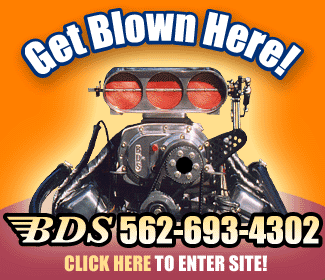|


Jim Dunn and Henry
Valasco in the Drag Racing Magazine
sponsored
Top Fuel car (Jim Gardner Photo)
In 1961 The Nationals moved from Detroit Dragway
to the brand new facilities at Indianapolis
Raceway Park. By 1964, my first year at
Indy, the Nats had found a permanent residence.
IRP provided the stage for drag racing’s
own version of a Greek play. . . the making
of legends, exhilarating triumphs, and
a few terrible tragedies.
In ‘64 my first impression IRP was how
far it was away from Indianapolis! Actually,
IRP was located not in Indy, but outside the
small Midwestern hamlet of Clermont. IRP was “so
far out in the boonies” that the front
gate on Highway 136, Crawfordsville Road, backed
up for several miles each day with traffic
trying to squeeze into IRP. This led to enterprising
safari trips to discover those few “back
roads” into the track and its massive
grounds. Today the surrounding acreage holds
subdivisions, “suburban farms” and
the evidence that civilization is quickly enveloping
what in 1964 was wide, uninterrupted expanses
of Indiana cornfields.
One of our secret “back roads” was
an early turn onto Girls School Road, and then
a narrow paved road that took you to the back
gate. It was along this road that I “discovered” my
first “real” apple tree. As a Miami
kid, I knew what mango, avocado and coconut
trees were, but for me apples came not from
trees, but the supermarket.
Another “must see” were the campgrounds
hosted by the Clermont Lions Club.In those
days Indy had few motels on its west side,
and rooms were all but impossible to find.
The Lions opened their club grounds to those
who wanted to “camp out,” and just
as many racers spent their Nationals week sleeping
in tents or the back of cars and pick-ups.
The campers ate the Lions pancake breakfasts
and washed away the grime at the community
ADVERTISEMENT
 |
|
showers. It all seems so far removed now, but
in 1964 everyone enjoyed the camaraderie that
The Nationals always seemed to produce.
Another attraction was the endless varieties
of race cars being wrenched beneath the Lions
campground’s huge oak and elm trees.
This was a lot of what ‘60s drag racing
was about.. . racers helping racers.
Although I managed to scrounge my way to Indy
to attend my first Nationals, I did so with “Not
Sufficient Funds” in my jeans. I was
down to my last few dollars, wondering how
I would make it home when an old pal came to
my rescue. In 1964 NHRA also presented a hot
rod and custom car show, at the Murat Shrine
building in downtown Indy. He must have sensed
my financial situtation, because Ernie Schorb,
a friend and the promoter and manager of drag
racing in the Miami area, asked if I’d
like to earn a few extra bucks manning the
NHRA souvenirs booth at the car show.
That Friday night I eagerly began my tour
as a “temporary NHRA employee,” selling
12th Anniversary t-shirts and other items.
A second “sales associate” accompanied
me, a fellow Cabriolets car club member named
Jimmy Marrone. It turned out that we were actually
working for Chick Saffel, NHRA’s first “souvenir
king”. Chick eventually created an empire
that became known as Sport Services. Right
after the ‘64 Nationals Jimmy Marrone
went to work for Don Garlits at Garlits’ old
Nebraska Avenue shop in Tampa. He began as
a parts washer and helper and ultimately became
a Garlits crewman for several years. It’s
Jimmy who appears in the famous Garlits “Six-Second
Beard Shave” photo shot immediately after
Garlits completed his “come-back” win
at the 1967 Nationals. Our duties ended when
the show closed Sunday night, but Chick Saffel
and I have remained friends to this day.

|